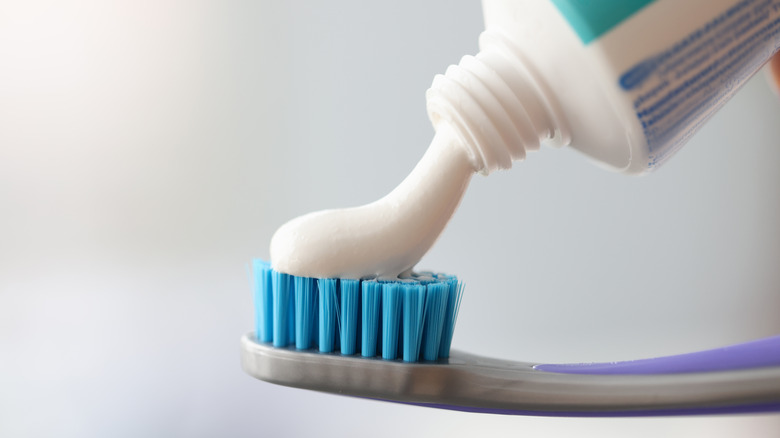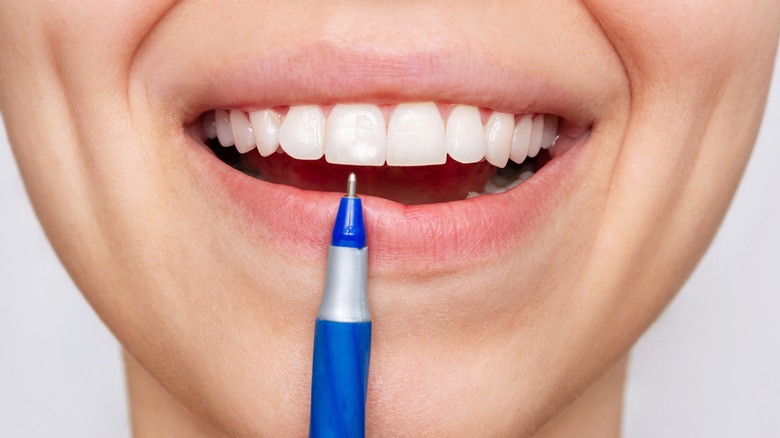Everything You Wanted To Know About Fluoride
Fluoride is nature's tool for fighting cavities. Being one of the most abundant minerals on the planet (via Life), fluoride is widely dispersed throughout nature. It is found in soil, fresh water, certain foods (via Australian Academy of Science), and is commonly added to public water sources as well as many over-the-counter dental hygiene products, according to the American Dental Association (ADA).
In the early 1900s, it was discovered that fluoride can help reduce the risk of dental cavities and tooth decay (via the British Dental Journal). In 1945, Grand Rapids, Michigan, became the first city in the U.S. to add fluoride to its public water supply, and by 1955, Proctor & Gamble's Crest launched the very first fluoride-containing toothpaste.
Fluoride, when consumed in the recommended amounts, has several health benefits, most notably reducing the risk of cavities, re-mineralizing teeth, and preventing tooth decay (per Oral Health). While there is a substantial amount of controversy among the general public over the safety and efficacy of fluoride, mountains of scientific evidence support that fluoride does an incredible job in reducing the incidence of cavities and tooth decay, while remaining safe for those who use it, according to the Centers for Disease Control and Prevention (CDC). Top medical organizations and health institutions in the U.S. and across the world overwhelmingly support its use.
What is fluoride, and where does it come from?
Fluoride (the ionic form of fluorine) is a common element found in the earth's crust (via Preventative Nutrition and Food Science). The majority of fluoride present in the environment can be traced back to volcanic rocks (per Materia Socio-Medica). It enters into the environment through a variety of processes, ranging from volcanic eruptions and natural leaching of rocks into waterways and aquifers, to various human activities such as the burning of fossil fuels and use of fertilizers in large-scale agriculture. For these reasons, fluoride is most commonly found in natural waters, including freshwater and seawater, as well as in a wide range of plants and aquatic species.
Fluoride can also be found in moderate concentrations in a variety of meats, shellfish, and other foods. The five foods with the highest concentrations of fluoride include black tea, shellfish products (shrimps, clams), wine, green tea, and potato chips. In certain countries, fluoride has also been added to salt, with an estimated 30-80% of store-bought salt being fluoridated. Nevertheless, the majority of fluoride consumed comes from two primary sources: water and dental hygiene products such as toothpaste and mouthwash.
Fluoride and its role in preventing cavities and tooth decay
While most of the fluoride you consume on a daily basis gets absorbed by your gastrointestinal tract, the small amount of fluoride that remains in your mouth, likely trapped in your saliva, happens to have the biggest impact on dental health (via Oral Health).
Your teeth are protected by a thin, translucent, yet incredibly tough outer shell known as enamel, which also happens to be the hardest material in the human body (via WebMD). Enamel helps to protect your teeth from daily activities such as chewing, biting, crunching, and grinding. Over time the enamel coating your teeth can begin to erode — whether through drinking too much acidic, sugary, and carbonated drinks, sucking on hard candies, or consuming diets high in sugar and carbohydrates. When this happens, it exposes the underlying and more delicate layer of dentin.
This is where fluoride comes in. Fluoride begins to work the moment it comes into contact with your enamel (via Oral Health). There are three main mechanisms by which fluoride strengthens your enamel and protects your teeth against cavities and decay. First, fluoride inhibits a process called demineralization, in which acids produced by bacteria in your mouth slowly dissolve the minerals that keep your enamel strong and healthy. Fluoride also enhances a process called remineralization, where it can actually force minerals back into the teeth. Finally, fluoride can inhibit the activity of bacteria that are responsible for causing decay (per Colgate).
Fluoride in toothpaste, mouthwash, and other dental hygiene products
Most toothpastes you'll find on the shelves of your local supermarket or pharmacy chain contain fluoride (via Oral Health Foundation). To be assured that your toothpaste is meeting the highest safety and efficacy standards set by the ADA, look for the ADA Seal of Acceptance, which can be found on over 200 over-the-counter dental products sold in the U.S.
Checking the labels on the front and back of your toothpaste can also give you a lot of information about the product (via Medical News Today). Under the Drug Facts, you should be able to find the list of active ingredients, which will more than likely contain some form of fluoride (sodium fluoride, stannous fluoride, sodium monofluorophosphate), per the ADA. Printed directly next to this, you will find the exact amount of fluoride ion in your toothpaste, which is usually expressed as % w/v (percent weight by volume of fluoride ion), according to Trade Science Inc. This is the most important value to pay attention to when selecting a toothpaste, as this is the amount of actual fluoride ion that is in the product. In addition, many other dental hygiene products like mouthwash and even dental floss also contain fluoride (per ADA and DenTek).
Professional fluoride treatments
Many dental offices offer professional fluoride treatments, according to The Journal of the American Dental Association. During these procedures, a dentist or dental hygienist will apply a prescription-strength fluoride to your teeth, often in the form of a rinsing solution, gel, foam, or varnish (via Tennessee Department of Health and Healthline). In many dental offices, these services are offered as add-ons with your routine dental cleaning.
The majority of professional fluoride treatments are done with a varnish, which is a highly concentrated form of fluoride (per ADA). The fluoride found in varnish is no different than the fluoride found in your toothpaste, except it is at a much higher concentration. For example, Colgate PreviDent varnish contains 5% sodium fluoride. Some brands also sweeten their varnish with xylitol and add artificial flavorings for kids (e.g., Orange Cream, Cool Mint, Bubble Gum) to make the overall experience more palatable (via Ultradent).
The application of fluoride varnish is a quick and painless procedure, and often takes no more than a minute to complete (via Tennessee Department of Health). The dentist or dental hygienist performing the procedure will use a small disposable application brush to apply a thin coat of the varnish to your teeth. While it isn't permanent, the varnish is designed to stick to the surface of your teeth and supply your enamel with fluoride over a period of several days. The procedure is extremely safe and is recommended in both children and adults for the prevention of cavities and tooth decay (per The Journal of the American Dental Association and Fluoride Varnishes for Dental Health).
Health impact of too little fluoride
In some parts of the world, limited intake of fluoride can be a real problem (via Caries Research). In the United States however, the average adult has a daily fluoride intake of about 2.9 mg, which is considered adequate by the National Institutes of Health Office of Dietary Supplements. Even in areas lacking water fluoridation, there are several dietary sources that provide an individual with an adequate amount of fluoride to limit the risk of developing cavities and tooth decay (per the World Health Organization). These sources of fluoride range from various foods to bottled water, and even the majority of soft drinks (via Journal of the American Dental Association).
Nevertheless, actions such as not brushing your teeth for extended periods of time with fluoride-containing toothpaste may place you at increased risk for conditions associated with poor oral health (via Colgate).
The primary concern with fluoride deficiency is the increased risk of developing cavities and tooth decay (per Merck Manual). Although somewhat controversial, another possible consequence of fluoride deficiency may be osteoporosis, a condition in which there is a chronic loss of bone density, placing individuals at a higher risk of fractures (via WebMD) . Interestingly, some studies have found that fluoride may actually be used as a potential treatment for osteoporosis (per Endocrinology and Metabolism Clinics of North America)
Thankfully, fluoride deficiency, if identified early, is very easily treated with the supplementation of fluoride-containing dental products, according to the ADA. Children ages 6 months to 16 years who are at increased risk for tooth decay or fluoride deficiency may be prescribed specially formulated tablets or lozenges containing fluoride.
Health impact of too much fluoride
Just as there are consequences when not consuming enough fluoride, problems may also arise from consuming too much. The U.S. Food and Nutrition Board has established a set of recommended dietary allowances for various minerals including calcium, phosphorus, magnesium, vitamin D, various B vitamins, and fluoride. The tolerable upper limit of fluoride has been established for a variety of ages and genders. According to these recommendations, the average adult over the age of 19 should not consume more than 10 milligrams of fluoride in their diet each day.
Acute toxicity from fluoride commonly results in gastrointestinal symptoms (abdominal pain, bloating, nausea, vomiting) and headaches, and is most commonly seen in children who have consumed large amounts of dental hygiene products such as toothpaste or mouthwash (via Mount Sinai). The addition of artificial sweeteners and bright coloring agents commonly added to these products likely contributes to many of these cases (per Poison Control). Other less common side effects of chronic fluoride overexposure may also include joint pain and stiffness (per Medical News Today).
On the other hand, chronic fluoride exposure over a prolonged period of time may result in a condition called dental fluorosis, which is seen as white or brown speckles that appear on the enamel (via Cleveland Clinic). This condition typically begins to occur when fluoride levels in drinking water exceed 1.5 mg/L (1.5 parts per million). Fluorosis is not harmful to your health and does not weaken your teeth. The only symptom is discoloration of the teeth, and treatment would likely require a cosmetic dental procedure such as teeth whitening or dental bonding.
Fluoride during pregnancy
Fluoride intake during pregnancy remains a controversial topic among medical professionals (via Science). A 2019 population study in JAMA Pediatrics found a link between fluoride consumption by pregnant mothers and lower IQ scores in their children. While many critics were quick to point out weaknesses in the study, the overall consensus by the medical community has been that much more research is needed before any definitive conclusions can be drawn (per NPR).
It has been well known since the 1980s that the placenta, the barrier that separates the mother and fetus, does a great job regulating the amount of fluoride in the mother's bloodstream that can reach the fetus (via Materia Socio-Medica). One study found that the fluoride concentration in the placenta remains at a constant 60% of that of the mother's serum, and that after birth the amount of fluoride that makes its way into the mother's breastmilk is very low.
While current research may be somewhat contradicting, current guidelines established by the National Institutes of Health (NIH) state that the level of fluoride required to ensure nutritional adequacy remains the same for all women, regardless of pregnancy status or lactation.
Fluoride in young children
According to the CDC, cavities are one of the most common chronic diseases affecting children. However, because they are preventable, there are many steps parents can take to keep their children cavity-free. It is important to remember that recommendations and guidelines vary based on a child's age, and that the child's dentist or pediatrician should be involved in the process of making any sudden changes to their dental hygiene regimen.
When it comes to fluoride, the CDC recommends that parents should switch their children to fluoride-containing toothpaste at the age of 2, and that children ages 2-6 should only be using a pea-sized amount of fluoride toothpaste, never swallowing, and rinsing well after each brushing. Parents are also recommended to help their children brush their teeth until they develop good brushing skills. These recommendations were made to maximize cavity prevention while also reducing the risk of dental fluorosis.
In addition to the fluoride found in toothpaste, children in the U.S. also consume various fluoride-containing foods, beverages, and tap water. Generally children in America are not considered at risk for fluoride deficiency unless they don't regularly drink from a fluoridated water source. In that case, speak to your pediatric doctor or dentist about whether or not your child may require supplementation.
Fluoride in drinking water
Fluoridation, according to the CDC, is the controlled process of adding fluoride to public water supplies, with the aim of reducing cavities and tooth decay in a population. As of 2018, 63.4% of U.S. households receive fluoridated tap water (per CDC).
The history behind fluoridation dates back to the early 1900s, when two dentists identified that residents of Colorado Springs, Colorado, were surprisingly resistant to developing cavities and tooth decay (via the National Institute of Dental and Craniofacial Research). They also noted that it was common for residents of this town to develop harmless yet grotesque appearing brown stains on their teeth, what we now know to be dental fluorosis. These dentists were able to attribute these findings to the high levels of natural fluoride in the town water supply.
After a few decades of scientific research, in 1945, the city of Grand Rapids, Michigan, became the first to add fluoride to its public water system, with the goal of reducing tooth decay in the population (via CDC). Since 1945, water fluoridation has become a standard practice in hundreds of cities and municipalities across the U.S. Community water fluoridation has led to a dramatic decline in tooth decay since its implementation, and this process was named by the CDC as one of the ten greatest public health achievements of the 20th century.
Myths surrounding fluoride
There are several myths surrounding the use of fluoride in drinking water. In a document posted by the Nevada Division of Public Health, many of these myths have been dispelled with plenty of evidence to back it up. Here are some examples:
One particular claim is that "fluoride does not belong in drinking water." Factually speaking, fluoride is already naturally present in almost all water supplies on the planet. It's almost impossible to avoid. Another claim is that "we already get fluoride in toothpaste, so we don't need it in our drinking water." However, the benefits stemming from fluoridated water add to those from the fluoride people are exposed to in toothpaste. Indeed, studies have shown that fluoridated city water systems significantly reduce the incidence of tooth decay. Other claims range from "fluoridation causes cancer" to "fluoridation doesn't really reduce tooth decay." In general, the truth is that many research studies have demonstrated both the efficacy and safety of fluoride within recommended amounts.
Does your home water contain fluoride?
In the U.S., 42 out of 50 states participate in the CDCs My Water's Fluoride (MWF) database. This is an online database that allows people to track whether their local water system fluoridates their water. MWF also provides information on the source of the water and the number of people that are served by any particular system. It is important to note, however, that MWF is a voluntary system, and states are not required to report the most up-to-date information. The fluoride levels listed in MWF may represent target values that the water system strives to achieve, but not the actual fluoride content added by their facilities.
Individuals curious about their water can also reach out to their local community water provider to get the exact fluoride content in their drinking water (per CDC). This name and contact information can be found on your water bill. By law, all community water systems in the U.S. are regularly tested. This ensures that the water you receive meets allowable levels of various minerals and organic compounds, including fluoride.
Houses running on well water can also find out about the fluoride content of their water by sending samples to their local state-certified water testing laboratory (via CDC). There, they can receive a report on the mineral content of their water.
Bottled water and fluoride
There are some pretty simple steps that can be taken to track or even limit the amount of fluoride you consume. Most bottled water companies list the fluoride (and other mineral) content on their website (per CDC). While it may sometimes require some extensive digging through the company's website, the vast majority of brands post annual reports (see this 2021 water quality analysis for Aquafina). In addition, many bottled water companies also list their water sources and explain their water filtration and purification process.
In April 2022, the FDA issued a final ruling that limits the allowable level of fluoride in bottled water to 0.7 milligrams per liter (mg/L). Before this ruling, the allowable level was 1.7 mg/L. This ruling was made in response to increasing evidence from the Public Health Service (PHS) that 0.7 mg/L is the optimal concentration of fluoride to prevent tooth decay without causing dental fluorosis.













